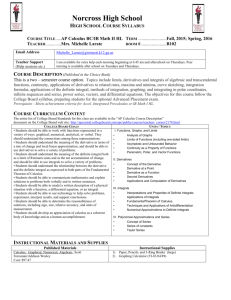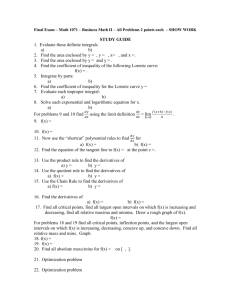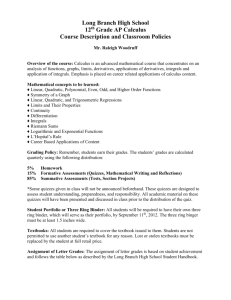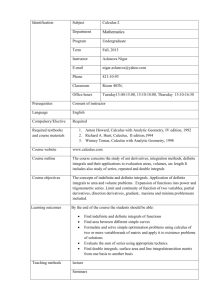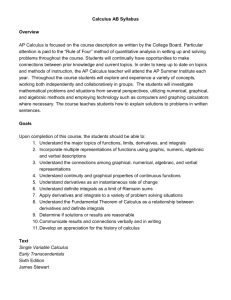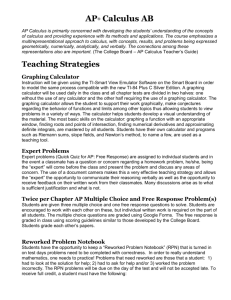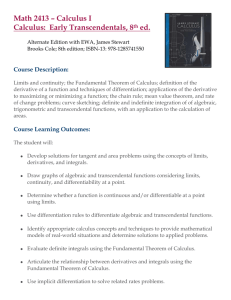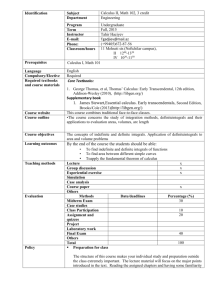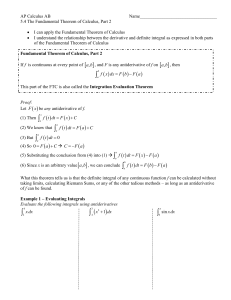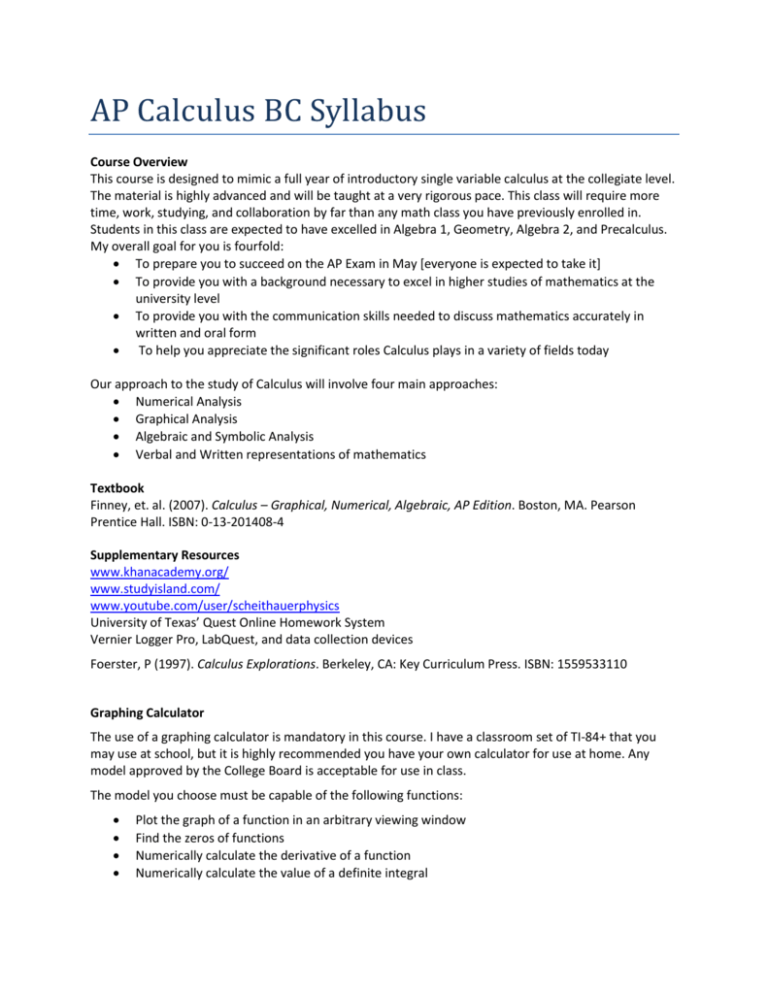
AP Calculus BC Syllabus
Course Overview
This course is designed to mimic a full year of introductory single variable calculus at the collegiate level.
The material is highly advanced and will be taught at a very rigorous pace. This class will require more
time, work, studying, and collaboration by far than any math class you have previously enrolled in.
Students in this class are expected to have excelled in Algebra 1, Geometry, Algebra 2, and Precalculus.
My overall goal for you is fourfold:
To prepare you to succeed on the AP Exam in May [everyone is expected to take it]
To provide you with a background necessary to excel in higher studies of mathematics at the
university level
To provide you with the communication skills needed to discuss mathematics accurately in
written and oral form
To help you appreciate the significant roles Calculus plays in a variety of fields today
Our approach to the study of Calculus will involve four main approaches:
Numerical Analysis
Graphical Analysis
Algebraic and Symbolic Analysis
Verbal and Written representations of mathematics
Textbook
Finney, et. al. (2007). Calculus – Graphical, Numerical, Algebraic, AP Edition. Boston, MA. Pearson
Prentice Hall. ISBN: 0-13-201408-4
Supplementary Resources
www.khanacademy.org/
www.studyisland.com/
www.youtube.com/user/scheithauerphysics
University of Texas’ Quest Online Homework System
Vernier Logger Pro, LabQuest, and data collection devices
Foerster, P (1997). Calculus Explorations. Berkeley, CA: Key Curriculum Press. ISBN: 1559533110
Graphing Calculator
The use of a graphing calculator is mandatory in this course. I have a classroom set of TI-84+ that you
may use at school, but it is highly recommended you have your own calculator for use at home. Any
model approved by the College Board is acceptable for use in class.
The model you choose must be capable of the following functions:
Plot the graph of a function in an arbitrary viewing window
Find the zeros of functions
Numerically calculate the derivative of a function
Numerically calculate the value of a definite integral
TEACHING STRATEGIES & CLASS ACTIVITIES
Explorations
Explorations are short math exercises that lead students to the introduction of new ideas. Explorations
will be worked individually and in a collaborative small-group setting where students may work together
and discussion the solution & implications of the exploration. Emphasis is also placed on correct written
communication of mathematical solutions and concepts. Explorations will also utilize the graphing
calculator to investigate relationships and concepts. Students will use graphical and tabular analysis to
test hypotheses and conclusions about accuracy of models and behavior of functions.
For example, on the first day of class, students will work an exploration where they derive a rate
function from the context of a problem. They then calculate the average rate of change over a relatively
large interval of time. Following calculations decrease the time interval to introduce the idea of limits
and instantaneous velocity. After given time to discuss the results with a partner, we will summarize the
findings as a class. At times, students will be assigned to facilitate the class wide discussion or to explain
their solutions to the class.
Labs
Labs will involve some type of data collection and/or manipulation to extend students’ understanding of
various topics. The overall purpose is to link theoretical understanding to real-world context and
concrete examples. Labs will use the graphing calculators to run simulations, analyze data, interpret
results and must use numerical results to support their well-written conclusions. Emphasis will be placed
on ability to express mathematical concepts, contexts, and solutions in sentence form.
An example of a lab is “Terminal Velocity” where students use a Vernier LabQuest and Motion Detector
to collect position versus time data of a coffee filter falling. Students will draw a sketch of the generated
graph and then must create the corresponding velocity and acceleration graphs. They must also describe
the terminal velocity in terms of a limit. Students will then find a curve-of-best-fit for the position vs.
time graph and use derivatives to generate the velocity and acceleration functions and compare the
graphs generated by these functions to the ones sketched previously. Students will also evaluate the
definite integral of these functions to compare the “theoretical” to “experimental” displacement and
change in velocity.
Quizzes
Quizzes will be given in a variety of formats (all formats at some time will be ‘calculator allowed’ and ‘no
calculator’). Again emphasis will be placed on students’ abilities to express mathematical solutions and
concepts in sentence form.
Traditional paper/pencil with multiple choice and open-ended problems
Remote voting system quizzes via the CPS Spark system
o Study Island will facilitate many of these quizzes
Take home quizzes
o Significantly more challenging problems where external resources may be used.
Group Quizzes
o Open-ended problems, typically of a higher difficulty, where the group must come to a
consensus on the solution. Only one piece of paper and one pencil will be provided so
cooperation and verbal communication skills must be utilized.
Homework Quizzes
o
I will ask for your full solutions to ‘randomly’ selected homework problems throughout
the past one to two weeks. Since you are only duplicating previously made solutions,
you will have very little time to complete these.
Exams
At least one exam will be given per unit. Each exam will consist of multiple choice and free response
questions – each divided into “Calculator” and “No Calculator” sections. On the free response section,
students will earn some points based on their ability to express solutions in full sentences that are in
harmony with the context of the problem.
Exam Corrections
Students will often have an opportunity to correct mistakes made on the exam to receive some partial
credit back on their score. Students will have to explain what they did wrong and how to correct the
problem and then write out the correct solution.
Homework
Homework will primarily be assigned from your textbook and supplemental materials I pass out in class.
I will not collect your homework, but will assign homework quizzes instead (see above). While every
problem may not be graded, it is to your advantage to complete all assigned problems. Students will
have plenty of opportunities to seek assistance on problems they are struggling to solve.
Supplemental problems and practice will be assigned through University of Texas’ Quest website and
Study Island. As a result, all students are required to obtain a UTEID and to enroll in my online course.
AP Exam Problem Sets
Students will be provided with released questions from prior AP Exams. This will require a sufficient
number of topics to be covered first (around the first 3 or 4 units). Students will work both individually
and collaboratively to determine solutions to the provided questions. As a class we will then review the
solutions and discuss test-taking strategies as well.
Project
Students will create their own tutorial videos to help review for the exam. They will be compiled and
hosted on the course website and YouTube channel to aid in reviewing for the exam.
Grading
Your grade for each grading period will be calculated using the following weighted categories. Your
overall grade will be compiled according to district policy. A semester exam will be administered at the
end of each semester.
Homework Quizzes, Labs, and Explorations………………………………………..30%
All other Quizzes………………………….…………………………………………………….30%
Exams………………………………………………………….…………………………………….40%
Course Outline
The units in the course correspond with chapters in your text. However, the content of the review
chapter will be integrated throughout the course.
Unit 1/Chapter 2: Limits and Continuity [~3 weeks]
Average & Instantaneous rates of change
Informal definition of a limit
Properties of Limits
One-sided and Two-sided Limits
Calculating limits algebraically
Using a table of values for a function to estimate a limit
Estimating limits graphically
Limits Involving Infinity
Understanding & Describing Asymptotes using Limits Involving Infinite
Sandwich Theorem
Continuity and Discontinuity
Limits of Algebraic Combinations and Composition Functions
Intermediate Value Theorem
Lines tangent and normal to a curve
Slope of a Curve
Unit 2/Chapter 3: Derivatives
Formal Definition of a Derivative & Proper Use of Notation
Calculating Derivatives Using the Definition
One-sided derivatives
Relating graphs of f(x) and f’(x)
Differentiability
o How the derivative at a point may fail to exist
o Relating differentiability to continuity
Evaluating Derivatives Numerically on a Calculator
Intermediate Value Theorem for Derivatives
Rules for Differentiation
o Power Rule
o Sums & Differences
o Products & Quotients
Higher Order Derivatives
Relating Derivatives to Real-World Context
o Instantaneous rates of change
o Velocity, acceleration, and jerk
o Assorted contexts (economics, etc.)
Derivatives of Trigonometric Functions
o Simple Harmonic Motion
Derivative of Composite Functions & The Chain Rule
o Applying the Chain Rule to the slope of parameterized curves
Implicitly Defined Functions and Implicit Differentiation
Derivatives of Inverse Trigonometric Functions
Derivatives of Exponential and Logarithmic Functions
Unit 3/Chapter 4: Applications of Derivatives
Absolute & Local Extrema
Mean Value Theorem
Increasing & Decreasing Functions
Relating the graphs of f(x) to f’(x) and f’’(x)
o First & Second Derivative Test for local extrema
o Concavity
o Points of Inflection
Modeling & Optimization in Various Contexts
Linear Approximation
Related Rates
Unit 4/Chapter 5: The Definite Integral
Estimating Finite Sums and the Rectangular Approximation Method
Riemann Sums
o Definition & Interpretation
o Left, central, and right methods
Definition & Notation of Definite Integral
Methods of Evaluating Definite Integrals
Estimating Definite Integrals with the Trapezoidal Sum Rule
Antiderivatives
o Of basic functions
o Finding specific antiderivatives given initial conditions
o Finding antiderivatives via substitution (and changing the limits of definite integrals)
Relating Definite Integrals to Area
Properties of Definite Integrals
Average Value of a Function
Mean Value Theorem for Definite Integrals
Relating Differential and Integral Calculus
Fundamental Theorem of Calculus
Analyzing Antiderivatives Graphically
Unit 5/Chapter 6: Differential Equations
Definition & Introduction To Differential Equations
Slope Fields
Euler’s Method
Andtidifferentiation & Indefinite Integrals
Antidifferentiation by Substitution
Antidifferentiation by Parts
o Product Rule
o Solving for Unknown Integrals
o Tabular Integration
o Inverse Trig & Log Functions
Separable Differential Equations
Exponential Growth and Decay & Modeling in Various Contexts
Logistic Growth
o Population Modeling
o Partial Fractions
o Logistic Differential Equations
Unit 6/Chapter 7: Applications of Definite Integrals
The Integral as Net Change
o Linear Motion, Work, Consumption Over Time, etc.
Area Between Curves
Area Enclosed by Intersecting Curves
Geometry Formulas
Integrating with Respect to y
Volume
o Cross Sections
o Shell & Washer Methods
Lengths of Curves
Unit 7/Chapter 8: Sequences, L’Hopital’s Rule, and Improper Integrals
Introduction to & Defining Sequences
Arithmetic & Geometric Sequences
Graphing a Sequence
Limits of a Sequence
L’Hopital’s Rule & Indeterminate Forms of Limits
Improper Integrals
o Infinite limits of integration
o Integrands with infinite discontinuities
Convergence and Divergence
Applications of Improper Integrals
Unit 8/Chapter 9: Infinite Series
Geometric Series
Power Series
Representing Functions by Series
Differentiation and Integration of Series
Taylor Series
o Series for sin(x), cos(x), e^x, 1/(1-x)
Maclaurin and Taylor Series
Combing Taylor Series
Taylor’s Theorem
Testing for Convergence
o nth-Term Test
o Comparing Nonnegative Series
o Ratio Test
o Integral Test
o Harmonic & p-series
o Comparison Tests
Unit 9/Chapter 10: Parametric, Vector, and Polar Functions
Parametric Functions
o Parametric Curves in the Plane
o Derivatives, slope, and concavity
o Arc Length
o Modeling, including displacement, velocity, and vector functions
Vectors
o Two-Dimensional Vectors & Relating to Parametric Equations
o Vector Operations
o Modeling two-dimensional motion
Polar Functions
o Polar Coordinates and Notation
o Types of Polar Curves
o Differentiating Polar Curves & Slopes of Polar Curves
o Integrating Polar Curves & Area Enclose by Polar Curves
Exam Review
Time permitting, we will spend approximately two or three weeks performing a cumulative review to
prepare for the AP Exam. Focus will be spent on problem-solving and test-taking strategies.
Post-Exam Topics
Our school year is slated to end before the AP Exam will be administered, so barring an excessive
amount of inclement weather days, there will be no post-exam topics to consider.

